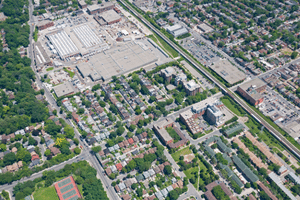
Top 11 Uses for Weather Data in Real Estate
Weather data plays a significant role in many facets of real estate.
Businesses involved at each stage of the property lifecycle across a range of industries and professions use weather data, together with other key data points, to make important strategic decisions.
Here we highlight the top 11 property-related processes where weather data serves as a valuable tool and why.

1. Zoning and Land Use
Government bodies and local councils consider weather data in planning decisions about zoning, development and land use to ensure the safety, sustainability, and functionality of urban areas. Examples include flood risk assessment, to avoid and manage heat islands, wildfire risk assessments, infrastructure resilience and emergency preparedness.
2. Location Selection, Urban Planning and Development
Urban planners and developers use historical data to make informed decisions about where to build new properties and infrastructure.
This data can help them identify areas with low risk of natural disasters and favourable climate conditions, which can impact liveability and attract more buyers and tenants.
Similarly, real estate developers and businesses considering new locations could use this data to make informed decisions about where to invest. Climate considerations affect the attractiveness of a location for both residential and commercial purposes. Investors in real estate often rely on historical data to formulate their investment strategies.
3. Building Design
Weather data has a substantial influence on building design and the choice of materials when creating structures that are not only functional but also durable, energy-efficient, and comfortable.
Heating and cooling, orientation, precipitation, weather events, energy efficiency and sustainability are just a handful of the factors considered by architects, engineers, and construction professionals in building design.
As weather patterns develop, longer-term planning of climate resilient developments that can withstand climate changes will rely on historical weather trends and patterns.

4. Construction Planning and Forecasting
Weather data is used very broadly in building construction.
Project scheduling of weather dependent tasks and site preparations; optimising resources, tradespeople and equipment; safety planning; the handling, logistics and protection of construction materials; environmental compliance all factor into construction planning and building contractual agreements.
Weather has such a profound impact on productivity and safety in the construction industry that a host of construction software, apps and technologies have emerged to improve the efficiency of planning, communication and management procedures and build resilience. And the companies developing this construction software incorporate weather data!
An example is UBIMET, an organisation specialised in high-precision meteorology and international weather services. Their range of offerings include weather solutions that allow construction companies to make informed decisions about their development projects.
5. Innovative Data-Based Engineering and Concept Designs
Weather data could be used in research and development, design or data-driven engineering (a framework for a new approach to technical product development), particularly of smart products in our built environment.
Engineers and designers can use this data to help plan, redesign and improve the design process and verify design concepts¹.


6. Seasonal Property Demand
At a simplistic level, weather data can help predict seasonal fluctuations in property demand, both in purchase and rental.
Real estate agents, and holiday rental marketers often use this data to target regions, seasons, highlight favourable weather conditions and seasonal attractions when promoting properties and timing campaigns.
For instance, a beachfront property may be marketed with historical or even real-time weather data showcasing sunny days and warm temperatures.
7. Property Protection, Maintenance and Repairs
Property managers may reference historical data to safeguard properties, anticipate environmental wear and tear, and gauge maintenance and repair needs, particularly in regions with higher risks of severe or extreme weather incidences.

8. Agricultural Real Estate
In rural areas, weather data is crucial for assessing the suitability of land for agricultural purposes.
Historical data can provide insights into factors like rainfall patterns, temperature ranges, and frost dates, which are vital for farming and land use decisions.
9. Risk Assessment
Weather and climate risk impacts all real estate assets in a broad sense. Weather data can help assess the potential risks associated with a property.
Historical data allows buyers, sellers, and investors to make informed decisions regarding property investments by understanding the past occurrences and potential risks.
Real estate risk assessments influence building design and construction; investor and asset manager decisions; insurance industry processes; banking and home loans; government resourcing and funding of community assistance services, policies and programs, just to name a few.
It has also given rise to a host of proptech tools, which ingest this weather data, to help stakeholders assess the risk to their real estate assets. An example of a climate risk report tool is ClimateCheck, and The World Bank offers climate and disaster risk screening tools designed to build resilience measures into project design.

10. Property Valuation
Historical weather data, among other factors, impact property prices and property valuation. While it may not be the sole determinant of property value, it can influence valuations, particularly in areas of weather-related risks.
And weather conditions can also impact insurance costs, desirability, liveability and saleability. Banks, real estate agents, government bodies and councils, property developers and investors are amongst those who would have a vested interest in the valuation of a property.
11. Insurance Planning
Weather data is vital for insurance planning.
Property owners or tenants rely on historical weather data to assess the risk of damage from weather-related incidents such as storms, flooding, or wildfires. This information can help them choose the right insurance coverage and understand potential insurance costs.
On the flip side, insurance companies use weather data to analyse and assess the risk when calculating premiums associated with insuring a property. Data analytics of weather information could also assist as a tool in identifying potential fraudulent cases.
Weather data has a versatile range of uses and plays a crucial role in all areas of the property lifecycle.
And judging by the range of weather intelligence software in market, weather data also plays a crucial role in software development to aid a wide range of industries, not just in real estate.
Weather data not only enhances property-related decisions but also fuels innovation in proptech, ushering in a new era of data-driven solutions that may help guide the buying, selling, construction and management of properties.
Source:
¹Ang Liu , Yuchen Wang , Xingzhi Wang, (2022) Data-Driven Engineering Design, Switzerland: Springer Cham
Weather Data Listings
The Proptech Cloud curates a range of weather data listings for use in real estate processes and analysis.
Subscribe to our newsletter
Subscribe to receive the latest blogs and data listings direct to your inbox.
